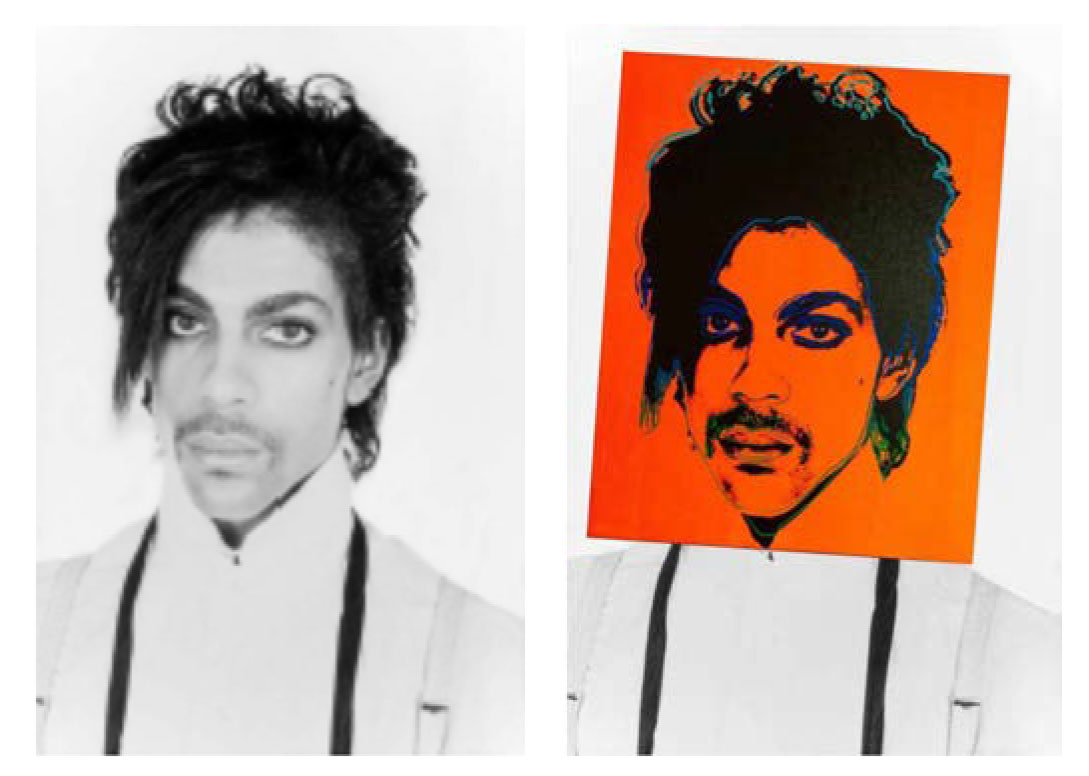
21 May The Graphic Artists Guild Applauds SCOTUS Opinion in Warhol v Goldsmith
The Graphic Artists Guild applauds the Supreme Court decision in The Andy Warhol Foundation v. Goldsmith, a case which had broad implications for graphic artists, and is recognized as a landmark copyright case regarding the interpretation of fair use. The SCOTUS opinion rejected 7-2 the Warhol Foundation’s argument that the artist’s use of photographer Lynn Goldsmith’s portrait of Prince was “transformative”, and therefor fell under fair use. In light of confusing and often contradictory analyses in lower court rulings, the SCOTUS opinion provides valuable guidance and limits on the consideration of “tranformativeness.”.
The background of the case is that in 1984, Vanity Fair licensed Goldsmith’s portrait of Prince for a one-time use as source material for a silkscreen by Andy Warhol. The silkscreen, with a credit to Warhol and to Goldsmith for the “source photograph”, appeared in an article about the musician. Warhol proceeded to make 15 additional artworks from the photograph without Goldsmith’s knowledge, some of which he sold.
Many years later, Condé Nast publisher contacted the Warhol Foundation (which manages Warhol’s works since his death) for permission to re-run the artwork in an article memorializing Prince. The Foundation directed the publisher to the other derivative works Warhol had created from the photograph, and they selected a different one. Goldsmith came across the commemorative article and, realizing her photograph had been used for at least one additional work, contacted the Warhol Foundation informing them they had infringed her copyrights.
The Foundation responded by suing Goldsmith for a preliminary judgement, stating that Warhol’s use of Goldsmith’s photograph was transformative. The district court granted the Foundation a summary judgement supporting of its claim of fair use. Goldsmith appealed that decision to the Second District and won, with the court reversing the lower court decision. The Warhol Foundation then appealed to the Supreme Court to challenge the Second District decision.
The Graphic Artists Guild and ASCRL issued a joint amicus brief in support of Goldsmith. In that brief we agreed with the Second District’s holistic approach to a fair use analysis of the Warhol work:
[We] do not necessarily agree that Warhol’s Prince Series embody no transformative meaning or message. Rather, amici endorse the court’s implicit understanding that the Prince Series are not transformative enough to override the remaining fair use factors. Transformativeness exists on a spectrum, with varying degrees of differences in purpose and/or character (as accomplished through new meaning, message, or expression) to be given corresponding varying degrees of weight in the overall fair use analysis.
Central to the entire case is the issue of “transformativeness” – whether and by how much a derivative work (a work based on a copyrighted work) imbues the original work with “new expressions and meaning”, thereby passing a fair use analysis. (“Fair use” is the doctrine that says it is “fair” to use a copyrighted work – under certain conditions – without permission from the copyright holder.) However, whether a work is transformative is only one consideration of four factors that are weighed in a fair use analysis.
The SCOTUS majority opinion stated that while “new expression and meaning” should be considered in a fair use analysis, it doesn’t override the factors. Among the considerations which need to be weighed are the purpose of the work, whether the use is commercial or not, and whether the right of the original copyright holder to create derivative works is impinged or not.
Goldsmith’s original works, like those of other photographers, are entitled to copyright protection, even against famous artists… Goldsmith’s photograph of Prince, and AWF’s copying use of the photograph in an image licensed to a special edition magazine devoted to Prince, share substantially the same commercial purpose. AWF has offered no other persuasive justification for its unauthorized use of the photograph.
The opinion also pointed out that giving “new expression and meaning” predominant weight in a fair use analysis would make it possible for someone to apply minimal changes to a work, apply it in a context that somehow changes the subject, and claim the work is “transformative”. That would leave photographers and other visual artists vulnerable to highly subjective interpretations of whether the unauthorized use of their work is infringing or not.
Image at top taken from the SCOTUS opinion. The image shows Lynn Goldsmith’s photograph on the left, and the Warhol derivative work superimposed on the photo on the right.
